You can prolong your blooms with this quick trick, says Diarmuid Gavin
Summer isn’t quite over yet, and in fact officially ends on Sept 22! So there’s still time to cram in some end-of-summer jobs that will have your garden looking tip top as we head into the new season.
JOBS TO DO THIS WEEKEND
- Get a head start with hardy annuals. These can be sown in situ or in trays.
- Squeeze the last drop out of flowers in hanging baskets, pots and containers – keep deadheading and feeding weekly.
- Meadow flowers that are dying back are ready for their autumn chop. Cut as close to ground as possible and remove any cuttings. This allows light in and helps new seed germination.
- Remove summer raspberry canes that have finished fruiting. Support fresh green canes which will bear next year’s fruit. It’s a good time to order fruit bushes so you can get them planted in the dormant season this winter.
- Dry days make good seed collection days. Armed with a brown paper bag and pen, shake the seed into the bag and label.
- Biennials such as foxglove may have self-seeded randomly around your garden – these can be dug up carefully and replanted where you want them.
- It’s a good time of the year for soil improvement while the earth is still pliable and not waterlogged – dig in your garden compost or fork in some well-rotted manure.
BULB TIME!
One of my favourite jobs every year is planting bulbs in autumn. Bulbs are one of the easiest plants to grow. These magical parcels contain everything the plant needs to mature and, when planted in the right conditions, delight in spring. Generally they prefer soil that is not waterlogged so if your soil isn’t free draining, consider planting in pots instead or at least put some grit beneath the bulbs to aid drainage. And remember the rule of thumb is to plant them at a depth of two or three times their height.
Spring bulbs are a valuable source of early nectar and pollen for our pollinating insects such as bees, hoverflies and butterflies, providing sustenance, along with spring-flowering shrubs, plants and trees. The pollen contains protein that helps them produce eggs and reproduce and bees will also use it to feed their young. Nectar is the carbohydrate that gives them energy. One of the earliest to flower is crocus that usually emerges in February just as the queen bumblebees are coming out of hibernation and need some protein to start reproduction.
‘Ruby Giant’ is a striking cultivar with large rich purple petals and a lovely fragrance. As it’s small it’s a good choice for window boxes or pots where you can inhale its lovely scent.
March brings muscari, known as grape hyacinth. It is also small enough for your window boxes or containers and the clusters of small flowers are packed with nectar. They will naturalise quite quickly in your borders and are a good choice for unpromising soil. The ribbons of rich blue flowers complement most spring planting schemes but if you want to keep them under control, confine them to your containers.
Modern hybrid daffodils and tulips have been bred for colour and elaborate petal shapes, rendering many of them either difficult to access for pollinators or low in pollen and nectar. However the smaller species tulips have simple open nectar rich blooms and have the benefit of returning reliably year after year.
The ‘Pheasant’s Eye’ daffodil, Narcissus recurvus is not only beautiful but is also nectar and pollen rich. The pristine white petals and central orange and yellow corona make this a striking and elegant species that will naturalise well.
Alliums are a picnic for our flying pollinators. Also known as the ornamental onion, each flower head is made up of many small flowers so a bee can bop about from one to the other without using up much aviation fuel. ‘Purple Sensation’ is one of the best known and the sight of these perfect purple spheres dotted through a border is always a winner.
If you choose a variety of different bulbs that bloom at different times, you are keeping pollinators fed over a longer period. We need these little insects to fertilise our crops, so it works both ways. Pollinators have been in decline due to habitat loss and pesticide use but by planting spring bulbs over the next few months, we can help restore some of their numbers.


















